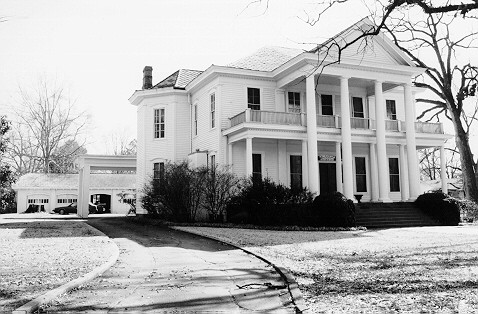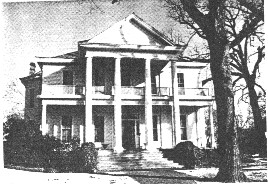T. L. James Home - "The Big House"
Introduction
Text-to-speech Audio
The T. L. James House is a two-story wood frame residence which reflects the late Italianate and Colonial Revival tastes. Built in 1884 by Colonel Thomas Cunningham Standier and remodeled in 1926, locals usually refer to it as "The Big House."
Standifer, a colonel during the Civil War, maintained a general merchandise store at Old Trenton. He purchased the entire block #6 from Robert E. Russ for $450.00 cash on January 3, 1884 and built the house the same year as Ruston began as a new town. The present front, including the columns, were added by Mr. T. L. James in 1926.The house is built with square nails, and the trim is white pine from Michigan. The downstairs ceilings are 13 feet high. There was originally a lightered (pitch pine) picket fence around the block.
The home remained in Col. Standifer's family until the death of Mrs. J. D. Barksdale (Olive Standifer) in 1913, when it was purchased by Mr. G. A. Adams who already had bought the northern half of the lot from the Standifer heirs.
Mr. T. L. James, then living in Dubach, purchased the home in 1921, moving here with his wife and six children in the summer of 1921. James created one of the largest construction companies in the South, building many highways, bridges, and buildings. The property was later maintained by the T. L. James & Company, Inc. for corporate use. T. L. James died in 1944 and Mrs. James died in 1964.
The structure and grounds were extensively remodeled in 2022 to serve as a special events venue.
Images
T. L. James House

Old Photo of T. L. James House

Backstory and Context
Text-to-speech Audio
The T. L. James House is a two-story wood frame residence which reflects the late
Italianate and Colonial Revival tastes. Built in 1884 and remodeled in 1926, the house has a central
hall plan, two rooms deep, with a rear kitchen “L” wing. It is located in the old residential section of
Ruston a few blocks from the downtown area and has been altered very little since the 1926
remodeling.
The following features date from the original 1884 period of construction:
1. The basic plan and configuration of the house, including the polygonal bay on the
north side.
2. Most of the windows with their molded surrounds and pediment shaped tops,
3. The rear gallery columns.
4. The two remaining chimneys,
5. All but one of the mantels, The original mantels are heavy in proportion and
feature boldly molded panels and deeply cut flutes.
6. Most of the interior moldings, doors, door surrounds, etc.
7. The paneled wainscoting in the hall,
8. The staircase with its heavy balusters and faceted, paneled newel,
The following features date from the 1926 remodeling:
1. The present facade treatment with its Palladian looking combination of a colossal
Tuscan pedimented portico surmounting a wide single story gallery.
2. The denticular entablature which surmounts the building.
3. A few of the windows.
4. The present front doorway with its fanlight and side lights.
5. The fluted pillars in the central hall.
6. The Adamesque mantel in the north parlor.
7. The wide columnar opening in the dining room.
8. The denticular frieze in the north parlor.
9. It appears that the rear porte-cochere dates from 1926, hut this is not certain. If it
was built after 1926, it certainly was not much afterwards.
Recent changes include the loss of the upper half of one of the north chimneys, the
replacement of a set of pocket doors with a vinyl accordion style door, and the installation of a rear
fire escape. In our opinion these changes should be regarded as minor given the total scope of the
house's historic architectural fabric.
To the rear of the house is a five bay garage which is contemporaneous with the 1926
remodeling. It is listed as a contributing element because it dates from the period of significance and
because it illustrates the type of outbuildings pretentious 1920's residences had.
Specific dates 1926 remodeling
Builder/Architect Builder for 1926 remodeling T. L. James
The T. L. James House is locally significant in the area of architecture because it is the
finest example of the Colonial Revival style in the city of Ruston.
The Louisiana Historic Structures Survey has identified 718 50+ year old buildings in Lincoln
Parish, most of which are in the city of Ruston. Virtually all of Ruston's older structures date from the
late nineteenth and early twentieth centuries. The majority of Ruston’s older residences represent
the Queen Anne Revival or bungalow styles. The James House is one of about fifty residences
which show some Colonial Revival influence. Most of these, however, are merely irregularly massed
Queen Anne Revival houses with Colonial columns or else plain cottages.
The T. L. James House is conspicuous among this group because it is the only one which
features a colossal pedimented portico. This marks it as the apogee of the Colonial Revival style in
the city. The house has a handsome distinctive neo-Georgian articulation which links it with high
style tendencies of the day in larger cities. This cannot be said of many of Ruston's other period
houses, most of which are neither stylistically advanced nor architecturally pretentious.
The home now called the James House was built by Colonel Thomas Cunningham
Standifer. He purchased the land from Robert E. Russ for $450 on January 3, 1884, and proceeded
soon thereafter to build the house. It remained in the Standifer family until 1913, T. L. James
purchased the property in 1921 and remodeled the home in the Colonial Revival style in 1926.
Sources
Ruston Centennial Committee. Centennial Historical Tour, February 1st 1984. Accessed February 21st 2022.
blob:https://www.crt.state.la.us/054ac4c0-8265-46fe-a023-61f38b50cd02
Lincoln Parish Museum
